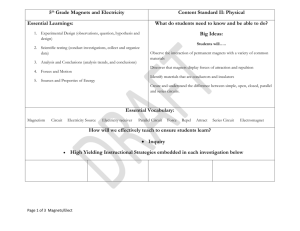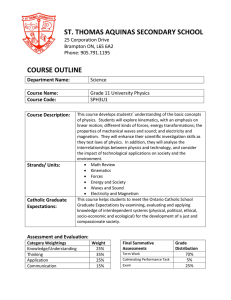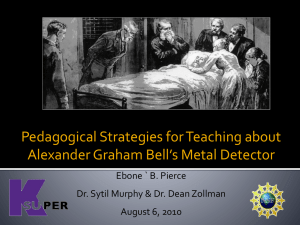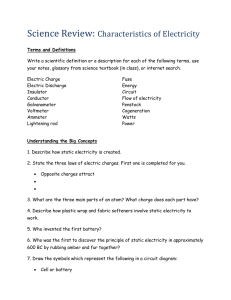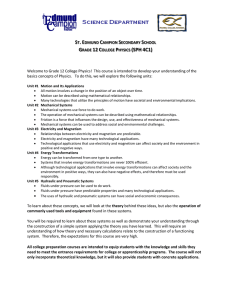MADISON PUBLIC SCHOOLS Grade 4 Science
advertisement
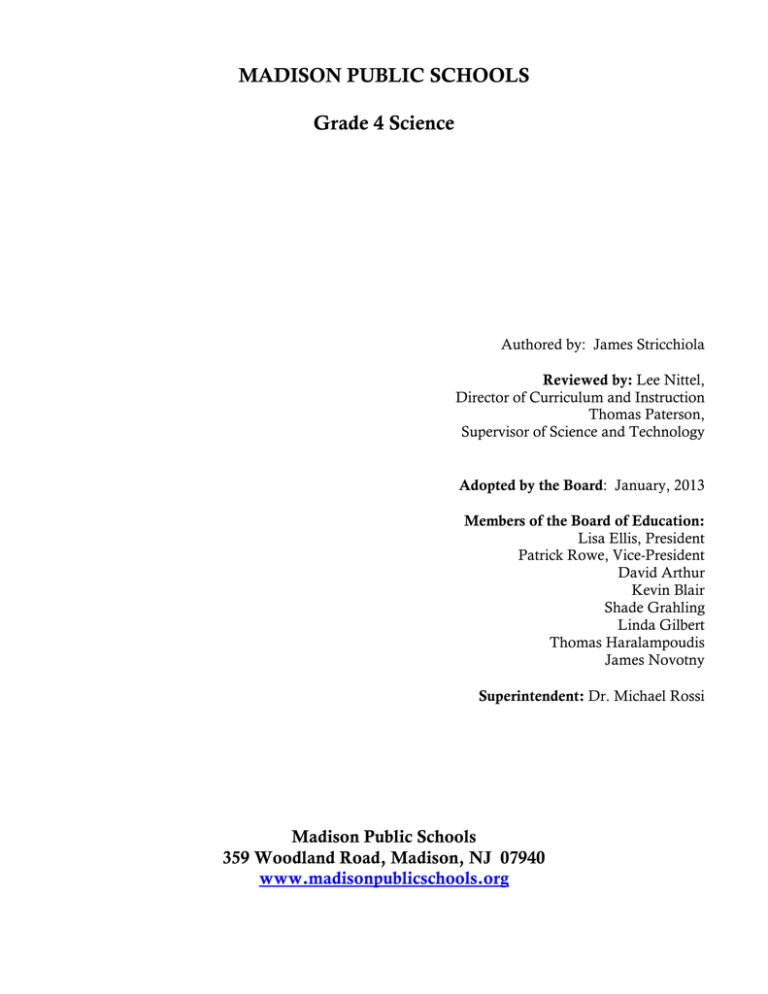
MADISON PUBLIC SCHOOLS Grade 4 Science Authored by: James Stricchiola Reviewed by: Lee Nittel, Director of Curriculum and Instruction Thomas Paterson, Supervisor of Science and Technology Adopted by the Board: January, 2013 Members of the Board of Education: Lisa Ellis, President Patrick Rowe, Vice-President David Arthur Kevin Blair Shade Grahling Linda Gilbert Thomas Haralampoudis James Novotny Superintendent: Dr. Michael Rossi Madison Public Schools 359 Woodland Road, Madison, NJ 07940 www.madisonpublicschools.org I. OVERVIEW The fourth grade science program is a full year course taught in heterogeneous elementary school classes. There is a three-cycle rotation schedule which allows the students to be actively involved in units of study in Physical Science, Life Science, and Earth Science throughout the school year. The curriculum is inquiry-based and is taught using science modules which provide enough materials for all students to actively participate in experiments and activities. This approach maximizes skill and conceptual growth in all students. The major topics covered during this year include the human body, magnetism and electricity, and the water cycle. II. RATIONALE The Madison Public School science curriculum is designed to provide students with experiences in all aspects of science. Science is best learned through collaboration and problem-solving, in an environment that leads students to construct their own knowledge of scientific principles. Attitudes such as curiosity, open-mindedness, and a thirst for knowledge ~ all essential to scientific inquiry ~ will be stressed. Within all fields of study, activities are provided for students to develop an understanding of fundamental scientific principles as well as the skills necessary to perform scientific investigations. This curriculum is designed to prepare students to meet future challenges with an inquiring mind and a foundation of scientific knowledge. The science curriculum is aligned with the NJ Core Content Curriculum Standards and is taught with an awareness of its connection to other subjects and the needs of society. III. STUDENT OUTCOMES (New Jersey Core Curriculum Standards) 5.1 Science Practices: All students will understand that science is both a body of knowledge and an evidence-based, model-building enterprise that continually extends, refines, and revises knowledge. The four Science Practices strands encompass the knowledge and reasoning skills that students must acquire to be proficient in science. 5.2 Physical Science: All students will understand that physical science principles, including fundamental ideas about matter, energy, and motion, are powerful conceptual tools for making sense of phenomena in physical, living and earth systems science. 5.3 Life Science: All students will understand that life science principles are powerful conceptual tools for making sense of the complexity, diversity, and interconnectedness of life on Earth. Order in natural systems arises in accordance with rules that govern the physical world, and the order of natural systems can be modeled and predicted through the use of mathematics. 5.4 Earth Systems Science: All students will understand that Earth operates as a set of complex, dynamic, and interconnected systems, and is a part of the all-encompassing system of the universe. IV. ESSENTIAL QUESTIONS AND CONTENT Human Body 1) What are the structure and functions of the skeletal system? (5.1; 5.3.4.A.2; 5.3.4.A.3) - There are 206 bones in the adult skeleton. - Bones are connected to each other at joints. - The skeleton protects organs, supports the body, and provides a place for muscles to attach to. 2) What are the functions of the muscular system? (5.1; 5.3.4.A.2; 5.3.4.A.3) - Muscles allow the body to move. - When muscles contract, they get shorter. When muscles relax, they get longer. Flexor muscles (biceps) allow a body part to bend when they contract. Extensor muscles (triceps) allow a body part to straighten when they contract. 3) What are the structure and functions of the circulatory system? (5.1; 5.3.4.A.2; 5.3.4.A.3) - The circulatory system consists of the heart, blood, veins, arteries, and capillaries. - The circulatory system pumps blood throughout the body. - The heart is broken up into four chambers. - The right atria and ventricle collect oxygen-poor blood and pump it to the lungs to become oxygen-rich. - The left atria and ventricle collect oxygen-rich blood and pump it throughout the body. 4) What are the structure and functions of the respiratory system? (5.1; 5.3.4.A.2; 5.3.4.A.34) - The respiratory system consists of the trachea, bronchus, lungs, alveolus, and diaphragm. - The respiratory system brings oxygen into the body and removes carbon dioxide from the body. - The diaphragm is the muscles that contracts to bring air into the lungs and relaxes to push air out of the lungs. 5) What are functions of the skin? (5.1; 5.3.4.A.1; 5.3.4.A.2; 5.3.4.A.3) - Skin protects the insides of body from germs and bacteria. - Skin regulates body temperature through perspiration. 6) What are the structure and functions of the teeth? (5.1; 5.3.4.A.2; 5.3.4.A.3) - Teeth are shaped differently because they have different functions. - The incisors and canines bite and tear food. - The premolars and molars mash and grind food. - The teeth help break down food so the nutrients can be used by the body. - The teeth are a part of the digestive system. Other organs in this system include the esophagus, stomach, and small and large intestine. 7) What is necessary for good nutrition? (5.1; 5.3.4.A.2; 5.3.4.A.3; 5.3.4.B.1) - Nutrition is the process whereby the body takes in nutrients to nourish the body. - Nutrients include vitamins and minerals, fats, carbohydrates, and proteins. - Fats provide the body with stored energy. - Carbohydrates provide the body with a source of quick energy. - Proteins allow the body to grow and repair itself. - The food pyramid is a tool that can be used to make sure a person gets the necessary nutrients from the five food groups. 8) What are the functions of the five senses? (5.1; 5.3.4.A.2; 5.3.4.A.3; 5.3.4.E.1; 5.3.4.E.2) - The five senses gather information from the environment. - The nervous system transports the messages received from the senses to the brain. The brain’s job is to then attach “meaning” to this information. Magnetism and Electricity 1) What are the properties of magnets? (5.1; 5.2.4.E.3) - Magnets stick to iron and steel. - Magnets attract or repel one another. - Magnetism can be induced in a piece of steel that is close to or touching a magnet. 2) What are the characteristics of magnetic force? (5.1; 5.2.4.E.1; 5.2.4.E.2; 5.2.4.E.3, 5.2.4.E.4) - Magnetic force causes magnetic interactions. The magnetic force of attraction between two magnets decreases with distance. 3) How does electricity flow? (5.1; 5.2.4.A.4; 5.2.4.C.1; 5.2.4.C.2; 5.2.4.C.3; 5.2.4.D.1, 5.2.4.E.1, 5.2.4.E.2) - A circuit is a pathway through which electric current flows. - A closed circuit allows electricity to flow; an open circuit does not. - A switch is a device that opens and closes a circuit. 4) How does electricity flow in a series circuit and in a parallel circuit? (5.1;5.2.4.A.4;5.2.4.C.1; 5.2.4.C.2; 5.2.4.C.3; 5.2.4.D.1, 5.2.4.E.1, 5.2.4.E.2 ) - An electric circuit is a pathway along which electricity flows. - A circuit with only one pathway for current flow is a series circuit. - A circuit that splits into two or more pathways before coming together at the battery is a parallel circuit. 5) What is an electromagnet? (5.1; 5.2.4.E.3) - Electromagnetism is magnetism created by current flowing through a conductor. - Electromagnets can be turned on and off. - The strength of the magnetism produced by an electromagnet can be varied. 6) How have electromagnets been used in everyday life? (5.1; 5.2.4.E.1; 5.2.4.E.2; 5.2.4.E.3, 5.2.4.E.4 ) - Science and technology are closely related. Science is knowledge of the natural world; technology is using scientific knowledge to modify the world to solve human problems. - An electromagnet is used to build a telegraph. - The telegraph allows people to send and receive messages. Water 1) What are the properties of water? (5.1; 5.2.4.A.2; 5.4.4.E.1; 5.4.4.G.1; 5.4.4.G.2; 5.4.4.G.3; 5.4.4.G.4) - Water is absorbed by some materials. - Water beads up in some materials. - The speed at which a bead of water flows on a smooth surface depends on the slope of the surface and the size of the water bead. 2) What is surface tension? (5.1; 5.4.4.G.4 ) - Surface tension makes a drop of water form beads and domes with a skin-like surface. 3) What are the three forms of water and their properties? (5.1; 5.2.4.A.2; 5.4.4.E.1; 5.4.4.G.1; 5.4.4.G.2; 5.4.4.G.3; 5.4.4.G.4) - Water may exist as a solid, liquid, or gas, depending on its temperature. - Changing the temperature of water may change its properties. - Cold water is denser than warm water. - Liquid water becomes solid water (ice) when it cools to zero degrees Celsius. - Warming ice to a temperature above zero degrees Celsius causes it to melt into liquid water. 4) What are the properties of water vapor? (5.1; 5.2.4.A.2; 5.4.4.E.1; 5.4.4.G.2; 5.4.4.G.4) - Evaporation is the process by which liquid water changes into water vapor. - Temperature affects the rate of evaporation. - The surface area of a liquid affects the rate of evaporation. - Condensation occurs when water vapor contacts to a cool surface and changes into a liquid. - Evaporation and condensation contribute to the movement of water through the water cycle. 5) How does water interact with different earth materials? (5.1; 5.3.4.C.2; 5.4.4.C.1; 5.4.4.C.2; 5.4.4.E.1; 5.4.4.G.3; 5.4.4.G.4; ) - Some earth materials absorb more water then other earth materials do. - Water flows more easily through some earth materials than through others. 6) How have people applied technology to water? (5.1; 5.4.4.F.1 ) - Flowing water can be used to do work. 7) What is water quality? (5.1; 5.4.4.G.4) - Water contains different materials that affect its quality. - Evaporation can be used to detect materials that may be dissolved in water. V. STRATEGIES The activities for each unit are detailed sequentially in the teacher’s manual for each kit. Teachers may extend the lessons with ideas provided in the manual, ideas suggested by the students, or ideas generated by the teacher herself. Teaching methods for the units include labs, direct instruction, lecture, cooperative groups, and small group instruction. VI. EVALUATION Student learning will be monitored with formative and summative assessments. Formative assessments are integrated into the labs for diagnostic purposes. Formative assessments include teacher observation, student sheets, response sheets, and performance assessments. Summative assessments are administered at the end of each unit. These include an end-of-the unit test and a portfolio assessment (optional). VII. REQUIRED RESOURCES Delta Kit and Teacher’s Manual ~ You and Your Body Foss Kit and Teacher’s Manual ~ Magnetism and Electricity Foss Kit and Teacher’s Manual ~ Water Supplemental Resources: Delta Science Readers ~ You and Your Body Foss Science Stories ~ Magnetism and Electricity Foss Science Stories ~ Water Additional resources listed on the following pages/sections of the teacher’s manuals: (These include internet resources as well as literature for students and teachers.) Delta Teacher’s Manual ~ You and Your Body: pages 123 and 124 Foss Teacher’s Manual ~ Magnetism and Electricity: Resources and Foss Website sections of the manual Electricity and Magnetism by Jenny Karpelenia, Perfection Learning Corporation 2004 Power Up Experiments, Puzzles, and Games Exploring Electricity by Sandra Markle, Macmillan Publishing Company, 1989 Text p.8-9 Foss Teacher’s Manual ~ Water: Resources and Foss Website sections of the manual Earth’s Water Cycle by Amy Bauman, Gareth Stevens Publishing, 2008 Inside Science Amazing Water by Maria Gill, Creative Teaching Press, 2009 Water A Resource Our World Depends On by Ian Graham, Heinemann, 2005 The Water Cycle- Evaporation, Condensation, and Erosion by Rebecca Harman, Heinemann, 2005 Nature’s Cycles: The Water Cycle By Sally Morgan, Rosen Publishing Group, 2009 One Well The Story of Water on Earth by Rochelle Strauss, Kids Can Press Ltd., 2007 VIII. SCOPE AND SEQUENCE The science program is a full year course. The units will be taught in this order: You and Your Body, Magnetism and Electricity, and Water. It is recommended that science instruction follow a pattern in which there are two 60-minute science classes one week and three 60-minute classes the following week. You and Your Body: Approximately 23 science classes or 10 weeks (* advanced preparation required) (**Lessons from the Madison Grade 4 Health Curriculum/textbook that can be incorporated into this science unit) **Introduction to the human body: TE pages B4-B7 Text pages B4-B7 Transparency 6 *Lesson 1: Human Bones ~ 1 day *Lesson 2: Muscles and Movement ~ 1 day Lesson 3: Reaction Time ~ 1 day *Lesson 4: Pumping Heart ~ 1 day Lesson 5: Lung Volume/Vital Capacity ~ 1 day *Lesson 6: Lung Function ~ 1 day *Lesson 7: Skin ~ 2 days (5 days apart) **Digestive System: TE page B15 Text page B15 Transparency 9 *Lesson 8: Teeth ~ 1 day *Lesson 9: Fat ~ 2 days *Lesson 10: Protein (Teacher demo due to harmful chemicals) ~ 1 day *Lesson 11: Carbohydrates (Teacher demo due to harmful chemicals) ~ 2 days Lesson 12: Nutrition ~ 2 days **Food Labels and Food Ads and Eating Healthful Meals and Snacks: TE pages B50-B53 Text pages B50-B53 Transparencies 17 and 18 **A Healthful Weight TE pages B66-B69 Text pages B66-B69 **Nervous System: TE pages B18-19 Text pages B18-19 Transparency 12 Lesson 13: Smell ~ 1 day *Lesson 14 Touch, Hearing, and Sight ~ 1 day **Stages of the Life Cycle: TE pages B20-B25 Text pages B20-B25 **Your Future Growth: TE pages B26-B31 Text pages B26-B31 Extension Lessons (optional) ~ 3 days End of unit review and assessment ~ 4 days Magnetism and Electricity: Approximately 23 science classes or 10 weeks Supplemental Investigations: The World Book Encyclopedia Presents Electricity Make It Work The Hands-On Approach to Science By Wendy Baker and Andrew Haslam, World Book 2004 Text pp. 18-19 Circuit Game, Text pp.24-25 Circuit Quiz Science Experiments With Electricity by Sally Nankivell-Aston and Dorothy Jackson, Franklin Watts 2000 Text p.14-15 In a Spin Investigation 1: The Force Part 1: Investigating Magnets and Materials ~ 1 day Part 2: Investigating More Magnetic Properties ~ 1 day Part 3: Breaking the Force ~ 1 day Part 4: Detecting the Force of Magnetism ~ 1 day Investigation 2: Making Connections Part 1: Lighting a Bulb ~ 1 day Part 2: Making a Motor Run ~ 1 day Part 3: Finding Conductors and Insulators ~ 1 day Part 4: Investigating Mystery Circuits ~ 1 day Investigation 3: Advanced Connections Part 1: Building Series Circuits ~ 1 day Part 2: Building Parallel Circuits ~ 1 day Part 3: Solving the String-of-Lights Problem ~ 1 day Investigation 4: Current Attractions Part 1: Building an Electromagnet ~ 1 day Part 2: Changing Number of Winds ~ 1 day Part 3: Investigating More Electromagnets ~ 1 day Investigation 5: Click It Part 1: Reinvent the Telegraph ~ 1 day Part 2: Sending Messages Long-Distance ~ 1 day Extension Lessons (optional) ~ 3 days End of unit review and assessment ~ 4 days Water: Approximately 31 science classes or 13 weeks Supplemental Investigations: Understanding Earth’s Water Supply. Text p.27 Earth’s Water Cycle by Amy Bauman, Gareth Stevens Publishing, 2008 How Much of an Apple is Water. Text p.5 Nature’s Cycles: The Water Cycle By Sally Morgan, Rosen Publishing Group, 2009 Investigate Rainfall. (www.powerkidslinks.com/natc/water) Text p.14 Nature’s Cycles: The Water Cycle By Sally Morgan, Rosen Publishing Group, 2009 Investigation 1: Water Observations Part 1: Looking at Water ~ 1 day Part 2: Surface Tension ~ 1 day Part 3: Water on a Slope ~ 1 day Investigation 2: Hot Water, Cold Water Part 1: Build a Thermometer ~ 1 day Part 2: Sinking and Floating Water ~ 1 day Part 3: Water as Ice ~ 2 days Investigation 3: Water Vapor Part 1: Evaporation ~ 2 days Part 2: Evaporation Locations ~ 5 days Part 3: Surface Area ~ 2 days (4 days apart) Part 4: Condensation ~ 2 days Investigation 4: Waterworks Part 1: Water in Earth Materials ~ 2 days Part 2: Waterwheels ~ 1 day Part 3: Water from Home ~ 3 days Extension Lessons (optional) ~ 3 days End of unit review and assessment ~ 4 days

